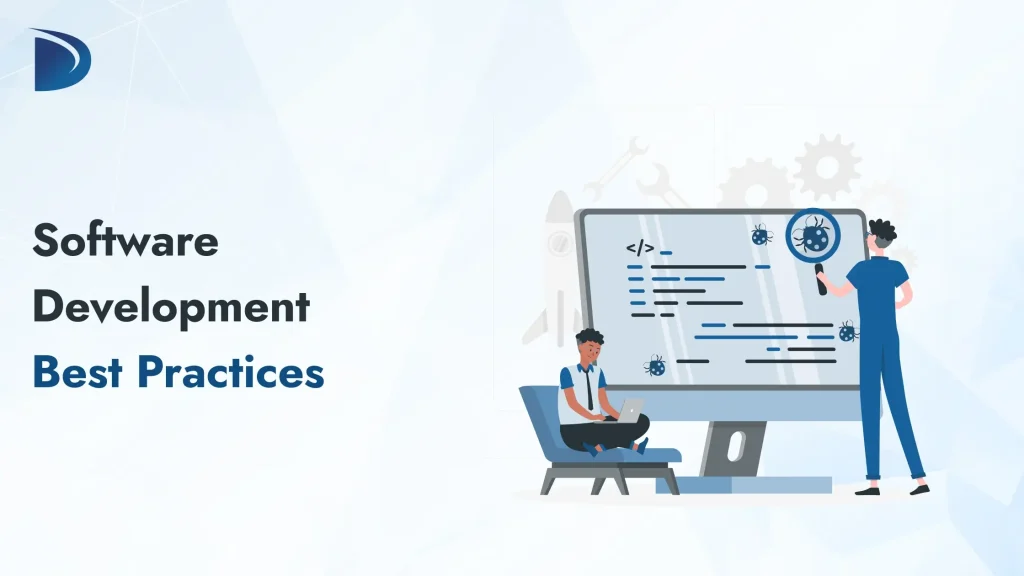Table of Contents
Ever opened a codebase and felt overwhelmed instantly, wondering how anyone could make sense of this tangled mess? You are not alone. Writing software is about crafting code that is clear, reliable, and can easily be maintained over time. Without the right habits, even a small project can turn into a nightmare full of bugs, confusing fixes, and endless rewrites.
The truth of the matter is: great software is the result of following smart, disciplined development practices every developer should know. Of course, in this blog, we’ll elaborate on those, along with putting a special spotlight on one quality practice for software development that genuinely makes a difference. Writing clean code. A practice that keeps your entire project healthy, scalable, and ready for whatever the future throws at it.
Key Software Development Best Practices
Creating high-quality software doesn’t happen by chance. It requires a set of proven best practices that help teams work efficiently, reduce errors, and build codebases that can be maintained. Below are some essential practices every software developer should embrace to ensure projects run smoothly and deliver lasting value.
Write Clean Code
Clean code is the entire backbone of any successful project. It indicates writing code that is simple to read, understand, and change, for anyone who works on it in the future. This requires using meaningful variable and function names, keeping functions short and focused, and avoiding unnecessary difficulties. Clean code helps reduce bugs, makes debugging easier, and speeds up onboarding for new developers.
Use Version Control Systems
Version control tools like Git are important for managing code changes and enabling teamwork. They keep a log of every change, permitting developers to collaborate without overwriting each other’s work. Writing clear, descriptive commit messages also makes it easier to understand why changes were made. Version control provides a safety net by allowing teams to roll back to previous versions if something goes wrong, keeping the software development process safe and transparent.
Test Regularly and Thoroughly
Testing is the most effective way to identify issues before they reach users. Automated tests (Such as unit tests for separate functions, integration tests for combined modules, and end-to-end tests imitating user actions) help make sure that software acts as expected. Regular testing grows confidence in your code, stopping regressions and reducing costly bugs in production.
Adopt Consistent Coding Standards
When everyone sticks to the same coding standards, the complete codebase becomes easier to read and maintain. Consistent naming conventions, formatting, and file organization lessen misreading and makes it easier to notice mistakes. Using automated tools like ESLint or Prettier imposes these standards, saving time and decreasing discussions about style.
Document Code and Processes
Good documentation goes beyond writing code comments. It describes the judgment behind decisions, defines how to set up and use the software, and simplifies difficult business rules. Comprehensive documentation helps onboard new developers faster, improves collaboration, and preserves knowledge when team members move on.
Conduct Regular Code Reviews
Code reviews are a strong way to upgrade software quality. By having fellows evaluate each other’s work, teams catch mistakes before they happen, share best practices, and maintain consistent standards. Reviews also promote knowledge sharing and help spread understanding of the codebase, reducing bottlenecks when only a few people know critical parts of the system.
Plan and Design Before Coding
Jumping straight into coding can lead to wasted effort and confusion. Taking the time to plan architecture, design features, and outline data flows ensures everyone is aligned and reduces the risk of costly rewrites. Creating wireframes, defining APIs, and sketching database schemas upfront can save significant time down the line.
Keep Solutions Simple
Simplicity is key to maintainability. Complex solutions often conceal bugs and hinder future development. Aim for straightforward approaches that solve the problem efficiently without adding unnecessary features or complicated logic. Simple code is easier to test, understand, and enhance.
Refactor Regularly
As software grows, code can become jumbled with outdated or twin logic; this is technical debt. Regular refactoring means revisiting and upgrading existing code without changing its behavior. This practice keeps the codebase clean, refines performance, and makes it easier to add new features afterwards.
Automate Where Possible
Manual tasks are lengthy and liable to errors. Automating repetitive processes like testing, building, deployment, and formatting releases allows developers to focus on creative problem-solving. Continuous Integration and Continuous Deployment (CI/CD) pipelines are industry standards that help deliver updates fast and faithfully.
One Quality Practice for Software Development
Out of all the best practices in software development, one is superior to others in terms of long-term effect: writing clean code. Clean code keeps projects maintainable, scalable, and easy to navigate, even as they grow more complex.
Why Clean Code Matters
Messy code works, until it doesn’t. Over time, quick fixes and shortcuts lead to confusing logic, twin code, and a codebase that’s impossible to maintain. Clean code lessens bugs, makes debugging easy, and lowers the cost of adding new features. It also makes collaboration easier, as other developers can understand your logic without needing to ask dozens of questions.
How to Write Clean Code?
Writing clean code is a mindset. It is about being thoughtful, deliberate, and always considering the developer who will read your code next, even if that developer is you six months from now. Here are the key principles that help make your code clean and maintainable:
1. Use Meaningful Names
Naming things is hard, but it is one of the most impactful habits you can develop. Choose variable, function, and class names that clearly describe their purpose.
- Bad: x, temp, calcRev
- Good: userAge, temporaryFilePath, calculateMonthlyRevenue
Clear naming makes your code self-documenting, reducing the need for extra comments and making logic easier to follow at a glance.
2. Keep Functions Small and Focused
Each function should do one thing and do it well. When a function grows too large or tries to handle multiple responsibilities, it becomes harder to read, test, and reuse. Break down large blocks of logic into smaller, purpose-driven functions. This promotes reusability, improves test coverage, and reduces the risk of future changes.
3. Eliminate Duplication
Duplicate code is a silent killer. It increases maintenance work and multiplies the chances of bugs. Whenever you find yourself repeating the same logic in multiple places, extract it into a reusable function or module. DRY (Don’t Repeat Yourself) is a key rule for sustainable development.
4. Comment Thoughtfully
Comments should add value, not restate the obvious. Explain why something is done in a certain way, especially if the logic is complex or not immediately intuitive.
- Bad: //loop through array
- Good: //Skip inactive users while calculating total purchases
Comments are there to explain the “why”, not the “what.” Let the code explain itself through a clear structure and naming. Use comments only when necessary.
5. Maintain Consistent Formatting
Formatting might seem surface level, but consistent indentation, spacing, and line breaks make code exceedingly easier to read. Use tools like Prettier, ESLint, or IDE settings to format your code automatically. Agreeing on a team-wide code style prevents unnecessary changes and makes collaboration seamless.
6. Handle Errors Gracefully
Never assume everything will go right. Validate input, handle exceptions, and provide helpful error messages that make debugging easier. Instead of letting the app crash, use try/catch blocks or error boundaries to manage failures smoothly. Clean error handling shows foresight and protects users from unexpected crashes.
Conclusion
Building high-quality software is about something sustainable, scalable, and easy to maintain. By following key best practices like writing clean code, testing thoroughly, using version control, and automating repetitive tasks, development teams can avoid common pitfalls and deliver reliable, future-ready solutions.
If you’re looking to build software that lasts, Differenz System can help! Our expert team follows industry best practices to deliver scalable, high-quality software tailored to your unique goals.
FAQs
How often should code be refactored?
There is no fixed schedule for refactoring, but it should be done regularly, especially after adding new features, fixing bugs, or when parts of the code become hard to understand. Adopting a “refactor as you go” mindset helps avoid technical debt buildup.
Is clean code more important than working code?
Both are important, but clean code ensures that working code stays maintainable in the long term. Code that just “works” might break easily or become unmanageable. Clean code makes fixing bugs and adding features much easier down the line.
What’s the difference between code comments and documentation?
Code comments explain specific pieces of code or logic inline. Documentation provides a broader view, like how to set up the project, how APIs work, or why certain architectural choices were made. Both serve different but equally important purposes.

